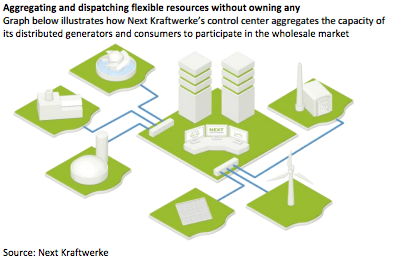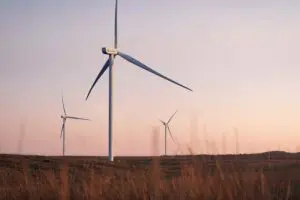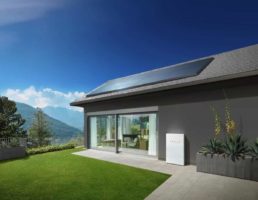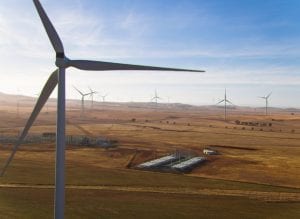EEnergy Informa
Among the threats facing incumbent utilities are virtual or digital utilities who offer similar services but at lower costs and/or with more desirable characteristics.
But that is not all. Clever startups are popping out offering new products or services not traditionally offered by utilities, or anyone else, for that matter. The new offerings are in response to the emerging needs of the market, and increasingly focused on aggregating the growing number of prosumers who may have excess generation, storage, flexible loads or a combination of the above and are willing and able to be proactive and price responsive.
One example of the latter is German- based Next Kraftwerke, a company that currently aggregates the load and generation of over 3,600 distributed power producers and consumers while optimizing their combined portfolio to take advantage of prevailing prices in the wholesale market.

Next Kraftwerke, whose generation portfolio is nearly 100% renewable, is keen on aggregating flexible resources such as biogas, hydropower, CHP plants, distributed generation and flexible industrial and commercial loads. These flexible resources/loads can be adjusted to balance wide fluctuations from wind and solar on the upstream of the network, which are increasing in frequency and magnitude, and not just in Germany (see article on page 19).
During windy or sunny periods, for example, when wind or solar output floods the grid, Next Kraftwerke can ramp up power consumption among its 3,600+ members to stabilize the grid – or ramp up generation when there is little wind and no sun. The company claims it already has sufficient ramping up and down capacity equivalent to 2 big coal fired plants. That is what this editor would call a virtual power plant (VPP), and a highly flexible one at that.
As a virtual utility, the company does not own any of the resources it manages – just as Uber doesn’t own any cars or Airbnb doesn’t own any rooms. Moreover, it does not only sell a commodity – electricity – but it also sells services – in this case flexibility to the grid. The company’s business model is similar to those covered in the July 2016 issue of this newsletter. 15 August 2016 EEnergy Informer Page 15
Aggregating and dispatching flexible resources without owning any Graph below illustrates how Next Kraftwerke’s control center aggregates the capacity of its distributed generators and consumers to participate in the wholesale market
Not surprisingly, Next Kraftwerke faces a lot of pushback from incumbents who are not happy to see a new entrant playing in their sandbox. It is no different than the resistance from taxi drivers or major hotels when Uber or Airbnb start to take customers away. Also regulators were initially skeptical, but after the concept had proved its merits with the German TSOs, the prequalification period shortened for each new European market they entered. The company is now spreading its successful business model beyond Germany (see company profile below right).
Like it or not, however, the variability of renewable resources, notably solar and wind, i
s a growing challenge to the stability and reliability of the grid. And flexible loads plus flexible generation and storage will increasingly be needed to keep supply and demand in balance.
 In Germany, renewables already provide more than 35% of electricity generation, a percentage that is rapidly growing as the country phase out its remaining nuclear plants by 2022. California, for example, is marching towards a 50% new renewable target by 2030. With such high levels of variable electricity production, baseload power plants and flat electricity tariffs where power costs the same at all times and all over the network are a thing of the past, or soon will be.
In Germany, renewables already provide more than 35% of electricity generation, a percentage that is rapidly growing as the country phase out its remaining nuclear plants by 2022. California, for example, is marching towards a 50% new renewable target by 2030. With such high levels of variable electricity production, baseload power plants and flat electricity tariffs where power costs the same at all times and all over the network are a thing of the past, or soon will be.
Increasingly, it is recognized that the value of electricity, whether it is consumed or generated, isn’t the same at all nodes on the network or at all times. Flexible producers feed power into the grid when the sun doesn’t shine and the wind doesn’t blow. Flexible consumers, on the other hand, take power out of the grid when the sun and wind flood the system. And that is precisely what companies such as Next Kraftwerke are planning to provide.
Among the valuable services Next Kraftwerke offers its members are the lowest-prices available at any time – allowing them to take electricity from the grid when it is cheapest – which happens to be the times when electricity is produced in abundance by solar and/or wind. For members with decentralized generation, the reverse applies, namely they can decide when to inject their excess generation into the grid. It is a classic case of win-win-win, for the aggregator, for the participants and for the grid operator.

Next Kraftwerke claims that consumers on average can save up to 30% on their electricity bills if they respond to the price signals. Those with distributed generation can earn even more if they produce electricity in times of scarcity. According to Next Kraftwerke’s CEO, Hendrik Sämisch,
“Since many energy markets in the world will be based on wind and solar in the long-run, our flexible electricity rates and the technology behind them could be key elements of future energy markets.”
Next Kraftwerke’s business model is straightforward. The company monitors the wholesale markets in real time and sends signals to its members through machine-to-machine (M2M) communication, asking them to ramp up or down depending on supply and demand conditions. It is an efficient and highly automated form of demand response to stabilize the grid.
It may sound complicated, but it is not rocket science. The big question is why more companies aren’t doing the same.
Fereidoon Sioshansi is president of Menlo Energy Economics, a consultancy based in San Francisco, CA and editor/publisher of EEnergy Informer, a monthly newsletter with international circulation. He can be reached at [email protected]










